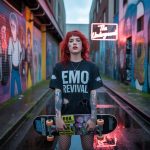Unveiling Emo Fashion Trends: A Deep Dive into a Unique Aesthetic

Emo fashion has always been more than just clothing—it is a lifestyle, a form of emotional storytelling, and a way to embrace individuality. Originating from the emo music scene of the late 1980s and early 2000s, this aesthetic quickly grew into a movement that combined music, art, and fashion. Today, emo fashion continues to inspire new generations who value creativity and authenticity, with essentials like band tees, studded belts, and men’s emo pants leading the way.
The Roots of Emo Fashion
Emo fashion first emerged alongside the emotional and raw music of bands like Rites of Spring and later gained mainstream attention with My Chemical Romance, Fall Out Boy, and Paramore. From the start, it was about more than just clothes—it was about representing vulnerability, intensity, and personal truth.
Key elements of early emo style included:
- Skinny jeans and men’s emo pants in dark shades.
- Band T-shirts featuring underground or popular emo bands.
- Black hoodies, wristbands, and accessories like studded belts.
This fashion was deeply personal, reflecting the emotional lyrics and aesthetic of the music itself.
Emo Fashion Today
Modern emo fashion has evolved while staying true to its roots. Today’s scene blends nostalgia with current trends, creating a hybrid style that resonates with both older fans and younger audiences discovering the aesthetic for the first time.
Some of the defining features today include:
- Layered outfits with flannels, hoodies, and fitted shirts.
- Graphic tees that showcase bands, art, or personal statements.
- Accessories like chokers, rings, and chains for added edge.
- Hair as self-expression, with asymmetrical cuts, bangs, and bold colors.
The look is less about following rules and more about making each outfit feel like an extension of your emotions and creativity.
Tattoos and Self-Expression
Tattoos have become a key part of the emo aesthetic. From heartbreak-inspired designs to lyrics and symbolic imagery, tattoos allow individuals to wear their emotions as permanent art. Common motifs include broken hearts, roses, stars, moons, and meaningful song lyrics—all of which mirror the intensity of the music and lifestyle.

DIY Culture in Emo Fashion
A major part of emo style is DIY creativity. From hand-painting T-shirts to distressing denim, the community embraces originality. Many fashion enthusiasts personalize their men’s emo pants with patches, pins, or cuts to reflect their own story. This do-it-yourself culture is what makes emo fashion stand out—it’s about being unique, not uniform.
Community and Belonging
Emo culture has always been about connection. Concerts, online communities, and social media platforms keep the spirit alive, giving people spaces to share their style, music, and emotions. The fashion itself becomes a way to belong to a culture where vulnerability and individuality are celebrated.
Emo Fashion’s Modern Influence
The influence of emo fashion has even reached mainstream fashion shows and streetwear collections. Elements like dark layers, graphic prints, and men’s emo pants are now seen on runways and among celebrities who embrace the aesthetic. With sustainable fashion on the rise, thrifted and vintage pieces are also becoming an important part of building an emo-inspired wardrobe.
Looking Ahead
The future of emo fashion is about inclusivity, sustainability, and continued individuality. No matter your background, gender, or style preference, there’s space to embrace emo fashion in a way that feels authentic to you. The core message remains timeless: express yourself, stay true to your emotions, and let your fashion tell your story.
Final Thoughts
Emo fashion is not just a trend—it’s a movement rooted in emotion, music, and identity. Whether you’re layering band tees, adding tattoos, or rocking men’s emo pants, each choice you make tells the world something about who you are. This is what makes the emo aesthetic powerful: it’s fashion with meaning, creativity, and heart.
Recent Posts
Categories
Related Articles
Ultimate Style Guide: Emo & Pop Punk Fashion with Black Emo Pants and Tripp Pants
Emo and Pop Punk aren’t just music genres—they’re entire lifestyles. From dark,...
ByemopantsOctober 6, 2025The Famous 2000s Emo Fashion — Is It Back with Emo Pants?
The 2000s were iconic for many reasons, but nothing defined that era...
ByemopantsOctober 6, 2025What It Really Means to Be Emo: Style, Culture & the Power of Emo Pants
Emo isn’t just a genre of music—it’s a way of life, a...
ByemopantsOctober 6, 2025Free Music Festivals in California & The Perfect Vibe with Emo Pants
California is more than beaches, palm trees, and Hollywood stars—it’s also home...
ByemopantsOctober 6, 2025















Leave a comment